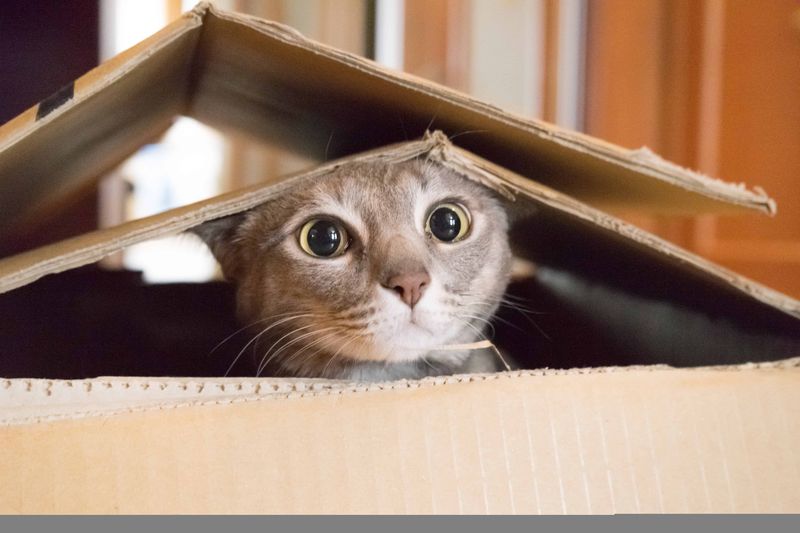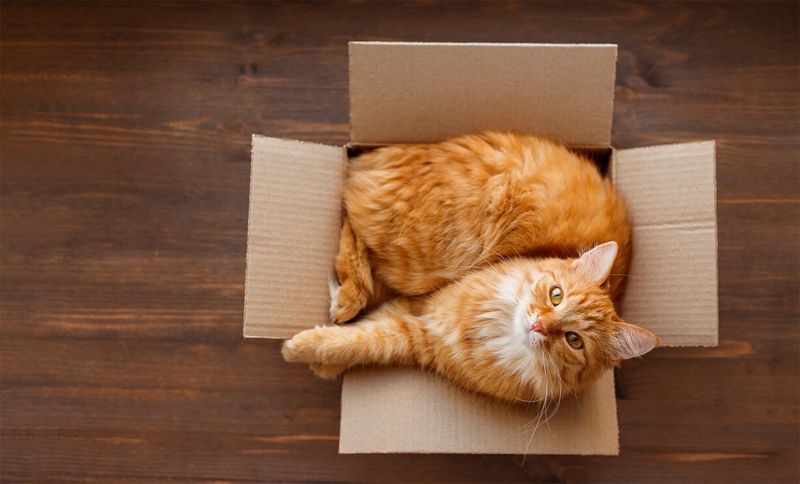📖 Table of Content:
- 1. Security and Safety
- 2. Warmth Retention
- 3. Play and Exploration
- 4. Stress Reduction
- 5. Territorial Marking
- 6. Nostalgic Comfort
- 7. Hunting Instincts
- 8. Sensory Enrichment
- 9. Privacy Needs
- 10. Curiosity and Novelty
- 11. Adaptable Comfort
- 12. Space for Hiding and Resting
- 13. Natural Instinct to Seek Enclosed Spaces
Cats are enigmatic creatures, capturing our hearts with their mysterious charm and quirky habits. Among their many peculiar behaviors, one stands out as universally beloved: their unyielding affection for boxes.
Whether it’s a towering shipping box or a tiny shoebox barely big enough to hold a paw, cats seem to find endless joy in these simple enclosures.
But why do these everyday objects hold such a magical allure for our feline companions? Is it their instinct for safety, their love for snug spaces, or something deeper rooted in their evolutionary past?
We’ll explore 13 unique reasons why cats love boxes, blending scientific insights, behavioral studies, and delightful anecdotes, offering a comprehensive look at why boxes seem to be a universal favorite among cats.
1. Security and Safety
Cats have an inherent need for security and safety, and boxes provide the ideal refuge. The enclosed space offers a sense of protection from predators, making it a perfect hiding spot. In the wild, cats are both predators and prey, and a box simulates a den-like environment where they can relax without fear.
Beyond just safety, boxes give cats control over their surroundings. They can peek out from a concealed position, observing the world without being seen. This vantage point enhances their ability to monitor potential threats or prey while feeling secure.
For domestic cats, the home environment can be unpredictable. Boxes offer a consistent sanctuary where they can retreat, recharge, and escape from the chaos. This behavior underscores their instinctual desire for a secure and reassuring habitat, reinforcing why boxes are so appealing to cats.
2. Warmth Retention
Boxes are excellent insulators, trapping warmth and creating a cozy space for cats to nap. The confined area helps retain a cat’s body heat, offering a warm sanctuary that can be especially appealing during colder months.
Cats naturally seek out warm spots to rest, and the thermal properties of a box make it an ideal choice. This preference is rooted in their biology, as maintaining a higher body temperature is crucial for comfort and health.
Beyond just warmth, the snugness of a box mimics the comforting embrace of a nest. This sensation is reminiscent of kittenhood, providing a nostalgic comfort that adult cats continue to crave. The combination of warmth and closeness makes boxes an irresistible retreat, merging practical benefits with emotional satisfaction for our feline companions.
3. Play and Exploration
Boxes are not just for resting; they are also perfect playgrounds for curious cats. The mystery of what’s inside or beyond the box ignites their adventurous spirit, encouraging exploration and play. Cats are natural hunters, and a box can simulate the excitement of stalking and pouncing on prey.
The unpredictability of a box adds to the thrill. Cats can hide within, leap out unexpectedly, or push and tumble the box around. This interactive play satisfies their predatory instincts and provides mental stimulation and physical exercise.
For indoor cats, boxes offer a refreshing change of pace. They introduce new textures, shapes, and challenges that keep a cat’s environment dynamic and engaging. This playful perspective highlights why boxes are more than just static objects; they are dynamic enclosures full of potential exploration and fun.
4. Stress Reduction
Stress is a common issue for cats, and boxes can significantly alleviate it. The enclosed space provides a safe retreat where cats can escape from stressors and find peace. This seclusion reduces anxiety, offering a calming effect akin to a personal sanctuary.
In multi-cat households, boxes can become essential for managing social dynamics. They offer a private space for individual cats to retreat and recharge, minimizing territorial disputes and fostering harmony.
The tactile sensation of a box also has soothing properties. The gentle pressure and enclosure can mimic the comfort of being held, offering emotional reassurance. By lowering stress and promoting relaxation, boxes serve as a vital tool in maintaining a cat’s overall well-being and happiness.
5. Territorial Marking
Territoriality is a significant aspect of feline behavior, and boxes play a role in this instinct. By occupying a box, a cat can mark its territory and establish ownership. The act of rubbing their scent glands on the box’s edges reinforces this claim, creating a familiar and comforting environment.
Boxes offer a defined area where cats can feel in control, helping them manage their space within a home. This control over territory is crucial for their sense of stability and confidence, impacting their interactions with other pets and humans.
Additionally, the visual and physical boundaries of a box provide a clear delineation of personal space. This boundary setting is vital for maintaining order and reducing potential conflicts. Through territorial marking, boxes become an essential component of a cat’s spatial and social dynamics.
6. Nostalgic Comfort
Cats often find comfort in boxes due to the nostalgia they evoke. The enclosed space mimics the nests they experienced as kittens, offering a sense of familiarity and safety. This connection to their early life stages provides emotional comfort and security.
The coziness of a box recalls the warmth and protection of their mother’s care. For many cats, this feeling is a profound source of reassurance and tranquility, making boxes a preferred resting place.
Beyond mere nostalgia, boxes fulfill a cat’s need for enclosed spaces, a behavior observed in wild feline relatives. This instinctual preference for dens and small shelters is ingrained, and boxes conveniently replicate these environments. The combination of nostalgic and instinctual comforts makes boxes an irresistible choice for many cats.
7. Hunting Instincts
Cats are born hunters, and boxes cater to this intrinsic instinct. The enclosed space allows them to hone their stalking skills, providing an excellent vantage point for observing and ambushing imaginary prey.
The element of surprise is crucial in hunting, and boxes offer the perfect cover for a stealthy approach. Cats can hide inside and leap out unexpectedly, mimicking the thrill of a real hunt. This practice is not only fun but also essential for mental stimulation.
Indoor cats, in particular, benefit from this simulation of the hunt. It keeps them engaged and satisfies their natural predatory drives, preventing boredom and promoting physical activity. By indulging their hunting instincts, boxes become much more than simple containers; they are arenas for imaginative play and skill development.
8. Sensory Enrichment
Boxes provide a rich sensory experience for cats, engaging multiple senses at once. The texture of cardboard, the smell of wood pulp, and the sound of crumpling edges all contribute to an intriguing environment for exploration.
Cats use their acute senses to investigate new objects, and a box presents a novel stimulus that can capture their attention. This sensory engagement is crucial for mental enrichment, keeping their environment stimulating and diverse.
Moreover, the act of exploring a box can encourage problem-solving and curiosity. Cats may claw at the edges, chew on corners, or maneuver themselves into tight spaces, all of which challenge their dexterity and cognitive skills. This multifaceted enrichment makes boxes an essential component of a cat’s interactive landscape, offering more than meets the eye.
9. Privacy Needs
Privacy is a fundamental need for cats, and boxes provide the perfect solution. The enclosed space offers solitude where cats can retreat away from prying eyes and disturbances. This ability to withdraw is vital for their emotional well-being.
A box serves as a personal haven, allowing cats to escape overstimulation and regain their sense of calm. This refuge is especially important in bustling households, where finding a quiet corner can be challenging.
By providing a private space, boxes empower cats to manage their interactions and environment. This autonomy over their surroundings enhances their confidence, allowing them to navigate social dynamics on their terms. For cats, the sanctuary of a box is not just a preference but a necessity for maintaining balance and peace.
10. Curiosity and Novelty
Cats are inherently curious creatures, and a new box presents a world of possibilities. The mystery of what lies inside or how it feels captures their attention, making boxes an endless source of fascination.
This curiosity drives exploration, as cats eagerly investigate the unknown aspects of a box. Whether it’s the scent of new cardboard or the potential of hidden treasures, each box offers a unique experience that satisfies their inquisitive nature.
The novelty of a box also prevents monotony in their environment. By regularly introducing new boxes, cat owners can keep their pets mentally stimulated and entertained. This continuous engagement is crucial for a cat’s happiness and well-being, transforming boxes into more than just packaging but portals to new adventures.
11. Adaptable Comfort
Boxes offer adaptable comfort, molding to a cat’s body and preferences. This versatility makes them ideal resting spots, as cats can adjust the box to suit their comfort needs.
The ability to shape their surroundings is empowering for cats, allowing them to create a personalized resting place. This customization is particularly appealing, as it aligns with their desire for control and comfort.
Moreover, the adaptable nature of boxes means they can fit in various spaces within a home, offering a consistent yet flexible sanctuary. Whether on a window sill or tucked in a corner, a box can transform any location into a cozy retreat. This adaptability underscores the universal appeal of boxes, making them a beloved choice for cats everywhere.
12. Space for Hiding and Resting
For cats, boxes offer a perfect hideaway and a sense of security. Imagine a cat curling up inside a snug box, feeling the walls close around it like a gentle embrace. This enclosed space provides a refuge from prying eyes, noise, and other potential threats.
In the wild, felines have an instinctual need to conceal themselves from predators, and boxes mimic the caves and crevices they would naturally seek.
The scent and texture of cardboard might also add an extra layer of comfort, making it an irresistible bed. This instinctive behavior creates a calming environment, ideal for resting.
13. Natural Instinct to Seek Enclosed Spaces
Cats are naturally drawn to enclosed spaces, a behavior rooted in their evolutionary past. When a cat finds a box, it’s like discovering a secret fort, a place to observe the world unnoticed. This behavior is linked to their survival instincts, as confined spaces allow them to monitor their environment while feeling protected.
Enclosed spaces like boxes provide a vantage point without exposing their presence, essential for a predator-prey animal.
Experts believe that this behavior is a comforting reminder of their days as kittens, nestled closely with their littermates, offering warmth and safety.













